|

Battle Relic: Push
dagger, created from shortened M3
fighting knife and M8 scabbard; U.S.
Army; World War Two.
Introduction: In 1992, a team
of archaeological divers from the "Mergor
in Mosa" (Latin for Submerge in the
River Meuse)- team were documenting
the remains of an ancient Roman
bridge from the 3rd century A.D., on
the bottom of the river Meuse in the
Netherlands. While exploring the
lower parts of the bridge's pillars
a small knife and scabbard were
found. It was found at approximately
43 to 54 yards off both banks; the
Province of Limburg on the East bank
and the Province of North-Brabant on
the West.
At the time, little attention was
given to this discovery because it
obviously was not Roman. Add to that
the fact that near the river landing
of Cuijk many discoveries had been
made in the river Meuse, which were
hardly of any value or dated from
World War Two. Because it had a
certain charm, the small knife was
thrown into a bin of miscellaneous
discoveries, probably to fall into
oblivion.
|
|
Item Description: The
knife measures 4.6 inches in length
and was composed of several "loose"
parts and had been assembled in a
make-shift fashion.
It can be described as follows: a
wooden handle (painted olive green)
to be held inside the palm of the
user's hand, a small length of an
iron rod with the double-sided tip
of a dagger welded to it.
The tip was placed inside an olive
green shaft made out of Bakelite.
The dagger was clamped inside the
shaft by means of a brass clasp but
has gone missing in the last number
of years.
|
(click for
an enlargement)
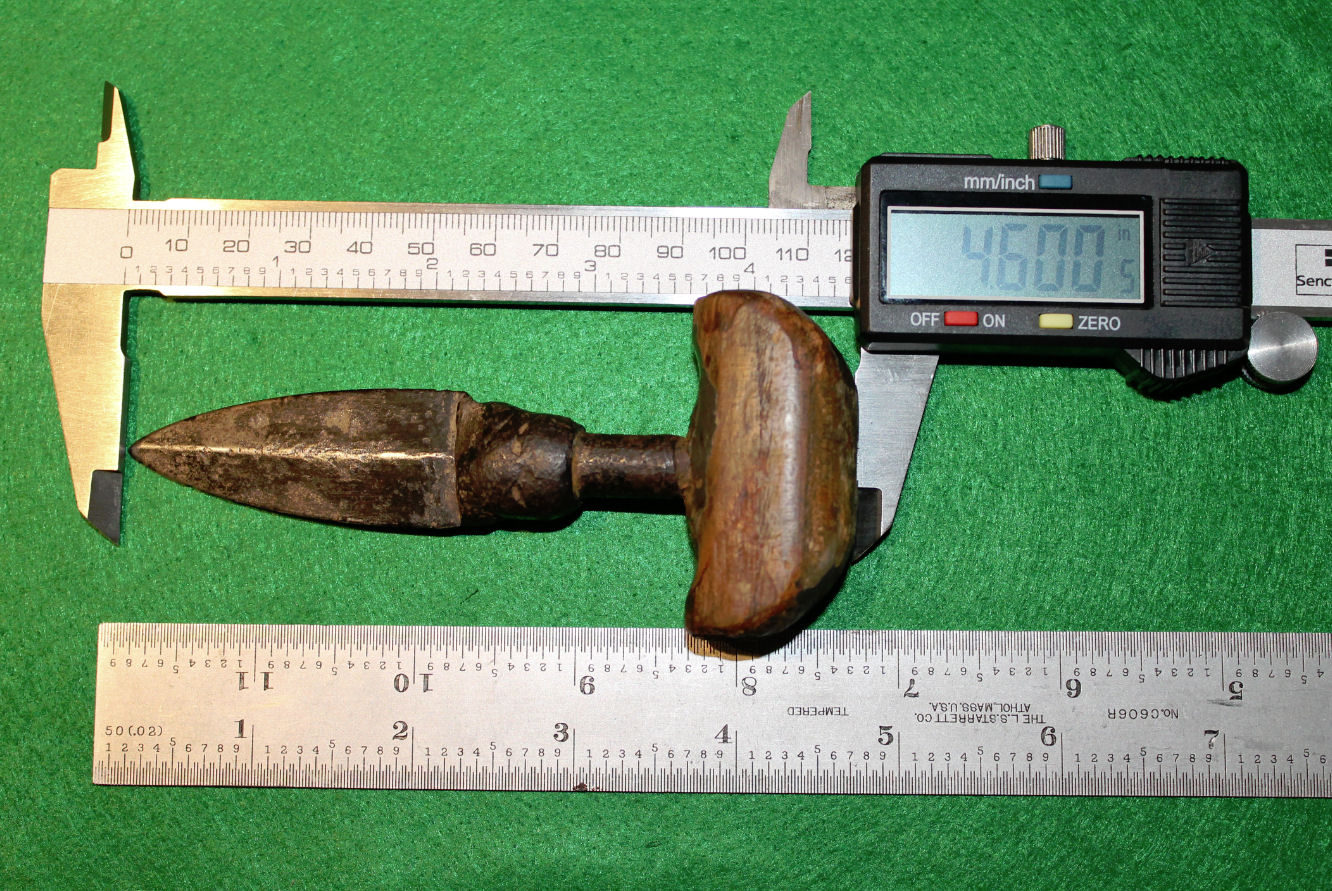 |
History: The knife had
an indisputable military character
but the divers had an abundance of
that kind from the river Meuse. One
day in 1997 it became a conversation
piece accidentally. An expert on the
subject of World War Two and weapons
who saw the knife recognized it as a
handmade fighting knife from a
member of the 505th Parachute
Infantry Regiment; a subunit of the
82nd All American (AA) Airborne
Division. The dagger was made from
none other than the blade of an
American M3 trench knife, part of an
M8 scabbard and a small metal
bracket from a machine gun
ammunition belt. These fighting
knives where used in hand-to-hand
combat and to cut the shroud lines
of parachutes in case paratroopers
got entangled during the jump.
The question was how the dagger
ended up where it was found in the
river.
On D-Day of Operation "Market
Garden" two refusals from "H"
Company of the 505th eventually made
their combat jump on the West bank
near Cuijk but there are no
known water landings of paratroopers
in the Meuse River. There had not
been any combat on this stretch of
the North-Brabant river bank and the
chance of someone throwing the knife
there (about 54 yards) from either
river bank was unlikely.
|
|
(click for
an enlargement)
.JPG) |
|
(click for
enlargements)
_small.JPG)
_small.JPG)
_small.JPG)
Left: Push
dagger from bottom of river Meuse
made from shortened M3 fighting
knife and M8 scabbard.
Center & Right: Push dagger
with pristine M3 knives and M8
scabbards. |
|
From a book titled "Cuijk
liberated and under fire" it was
learned in what manner the push
dagger and its scabbard found their
way into the Meuse. The book
features part of a report, told by
Dutch resistance fighters, dated
September 18 1944, during Operation
Market Garden.
On Page 36 & 37 of the book we read:
|
"Around noon on September
18, Van Sadelhoff and Sjaak
Roosenboom are on the top
floor of the Café of the Van
Sadelhoff's along the Meuse
using binoculars to scout
the far bank. They want to
know if there still are
Germans. To their utmost
surprise they see two
gigantic American
paratroopers in the Cuijkse
Steeg coming from the
direction of Mook on the far
bank. Cautiously the
paratroopers look around and
constantly duck for cover.
They also poke their rifles
between twigs and leafs to
see what is underneath them.
Thus they near the boat
where the Heere family
lives. A moment later the
men in the café see Jan and
Joep Heere rowing the two
paratroopers across the
Meuse towards Cuijk. Sjaak
Roosenboom - who speaks
English well- runs to the
paratroopers. They join
Sjaak up to the top floor of
the café to scour the wide
stretched embankments for
possible German troop
movements.
[…] one of the
paratroopers indicates that
he wishes to get inside the
tower of the large church.
From there he has a better
view over the river
forelands. Chaplain
Schoenmakers hands him the
key. Meanwhile Hans and Bert
Regouin have joined the
group. They too speak
English well. [Inside the
church tower] a hatchway is
opened and the paratrooper
can search the whole area
with his bino's. After
making some notes on his
map, the hatchway is closed
again and they all go
downstairs again. In the
mean time the other
paratrooper, who did not go
upstairs, went with Bert
Regouin and some other boys
from the underground
resistance to a farm house
in Vianen, with 5 Germans
still in there. They are
taken prisoner and moved to
Grave.
[…] … it is time to
rejoin their unit in Mook.
They reach the far bank of
the river Meuse in a boat,
rowed by Piet Heynen and
Frans van Bergen, who had
gone into hiding in Vianen.
A moment later the Americans
make contact with a German
patrol and have to hurry
back to the river head over
heels. Luckily the two men
have not left yet. One of
the paratroopers, who have
been shot at, is only hit in
his helmet. With all their
strength they row back to
the bank in Cuijk.
Fortunately they are not
shot at by the Germans.
Later they have returned to
their unit in the 505th
Regiment in Mook via Grave.
[The dairy entry of Bert
Regouin for September 18
1944:] At approximately
12:30 PM 2 American
paratroopers cross the Meuse
in a small boat to
reconnoiter the area.
Everyone is out of their
minds. The 2 paratroopers
are carried around the town
on our shoulders. Flags and
orange bunting appear. The
Wilhelmus [Dutch national
anthem] is sung. I show one
of them the way to a farm
with 5 Germans in it. He
goes there with some of the
boys from the resistance and
the Germans surrender. The
other American climbs the
church tower with Hans in
order to reconnoiter the
area.
[…] When the paratroopers
want to return to Mook, they
run into a German patrol on
the other side of the Meuse
and return to Cuijk. One of
them stays with us, the
other one at the Van
Sadelhoffs." |
|
|
Through the internet
we came into contact with Eduard Van
der Heyden, who was 7 years old when
the two paratrooper-scouts came to
his hometown Cuijk on that 18th of
September 1944. Today Eduard resides
in San Gabriel, California.
We asked
him about the incident and he
explained to us that he had seen the
first American paratroopers in
Cuijk; the two refusals who later
made a jump on the return flight of
their troop carrying C-47 on the
West bank of the Meuse. That was on
the 17th of September. When the two
scouts came into Cuijk on the 18th,
his father ordered young Eduard to
go home because of all the weapons
carried by the Americans. Ed had not
seen the dagger and assumes that
when "they crossed the river again
they ran into severe German
opposition and hastily came back
across the river aided by local
citizens. During the crossing they
threw most of their equipment
overboard to lighten their load."
From Bob Murphy, a veteran of the
505th, Ed learned that many
paratroopers had used self-made
knives during World War Two. Bob
himself didn't have one because he
had been a Pathfinder and most of
his load had been signal equipment. |
|
From the University of Ohio we
obtained the After Action Reports of
the various (Personnel,
Intelligence, Operations and Supply)
sections of the 505th Parachute
Infantry Regiment for Operation
"Market Garden".
Unfortunately they do not describe
the reconnaissance mission across
the river Meuse.
From this map, we can tell that "B"
Company of the 505th Parachute
Infantry Regiment was deployed near
Mook in the first stage of Operation
"Market Garden". |
|
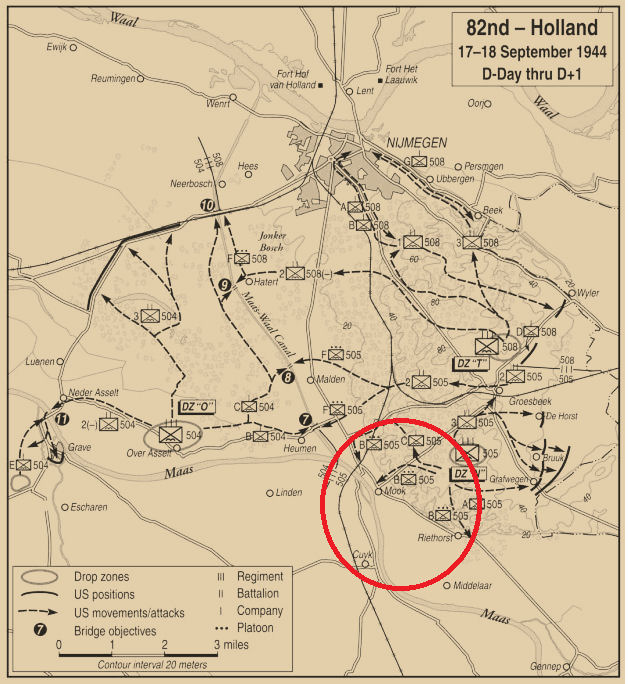 |
|
It is likely that the scout who lost
his dagger in the river Meuse was
a member of "B"/505th. |
Reproduction as part of
experimental archaeology
To understand how this Battle Relic
was constructed, we had the
privilege to have it on loan from
the diving team for a few weeks in
the Spring of 2013. |
We decided to create an accurate
reproduction of the dagger. From a
post-war M4 fighting knife, of which
the blade is similar in design to
World War Two US Army M3 knives, we
cut off its tip. We also took the
same length from the end of its
scabbard. We then welded two nuts on
a big steel screw and cut a notch in
the top of it. We placed the blade
tip in this notch and welded it on
the screw. From a hard type of wood
we created a handle of the same
design of the dagger from the Meuse.
We then drilled a hole in the handle
and screwed and glued the shaft and
blade tip in. We painted the handle
with red lead paint and the scabbard
with Olive Drab green. As a
finishing touch we poured battery
acid on the shaft and blade to give
it the weathered look of the
original specimen.
|
|
(click for
enlargements)
_small.jpg) _small.jpg) _small.jpg) _small.jpg)
_small.jpg) _small.jpg)
_small.jpg) _small.jpg)
_small.jpg)
_small.jpg) _small.jpg) _small.jpg) |
Upon return of the dagger to the
diver from whom we had borrowed it,
we made a comparison.
|
|
(click for
enlargements)
_small.jpg)
_small.jpg)
_small.jpg)
_small.jpg)
_small.jpg) |
The differences between our
reproduction and the original are as
follows.
- we only assumed that in the
original dagger bolts were used to
weld the blade to the shaft.
- we did not paint our wooden grip
olive green (and then chip most of
it off);
- the makers of the original dagger
most likely covered part of the
screw threads inside a short metal
pipe and welded it to the screw and
the bolts. We used a screw which was
only threaded on its lower part.
- we used an electrical welding
machine with considerable more amps
than the one used in World War Two.
This caused the tempered steel blade
to melt a little when it was welded
into the notch of the shaft. |
|
CONCLUSION:
This Battle Relic is an
interesting example of a warrior
trying to improve the standard
equipment he was issued. A push
dagger has a stronger thrusting
capability than a knife featuring a
blade with a handle in its
extension.
We were told that had the Roman
bridge not been where it was, the
river's current would have carried
the dagger down stream. That, or it
may have been frozen in ice on the
river's floor in winter time. When
thaw would set in, the river would
make the dagger drift down stream in
a lump of ice.
|
|
(click for
enlargements)
1)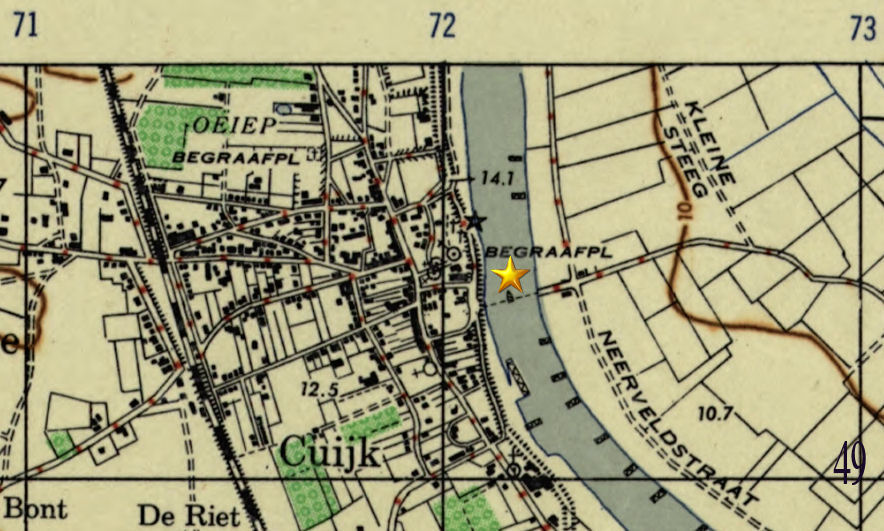 2)
2)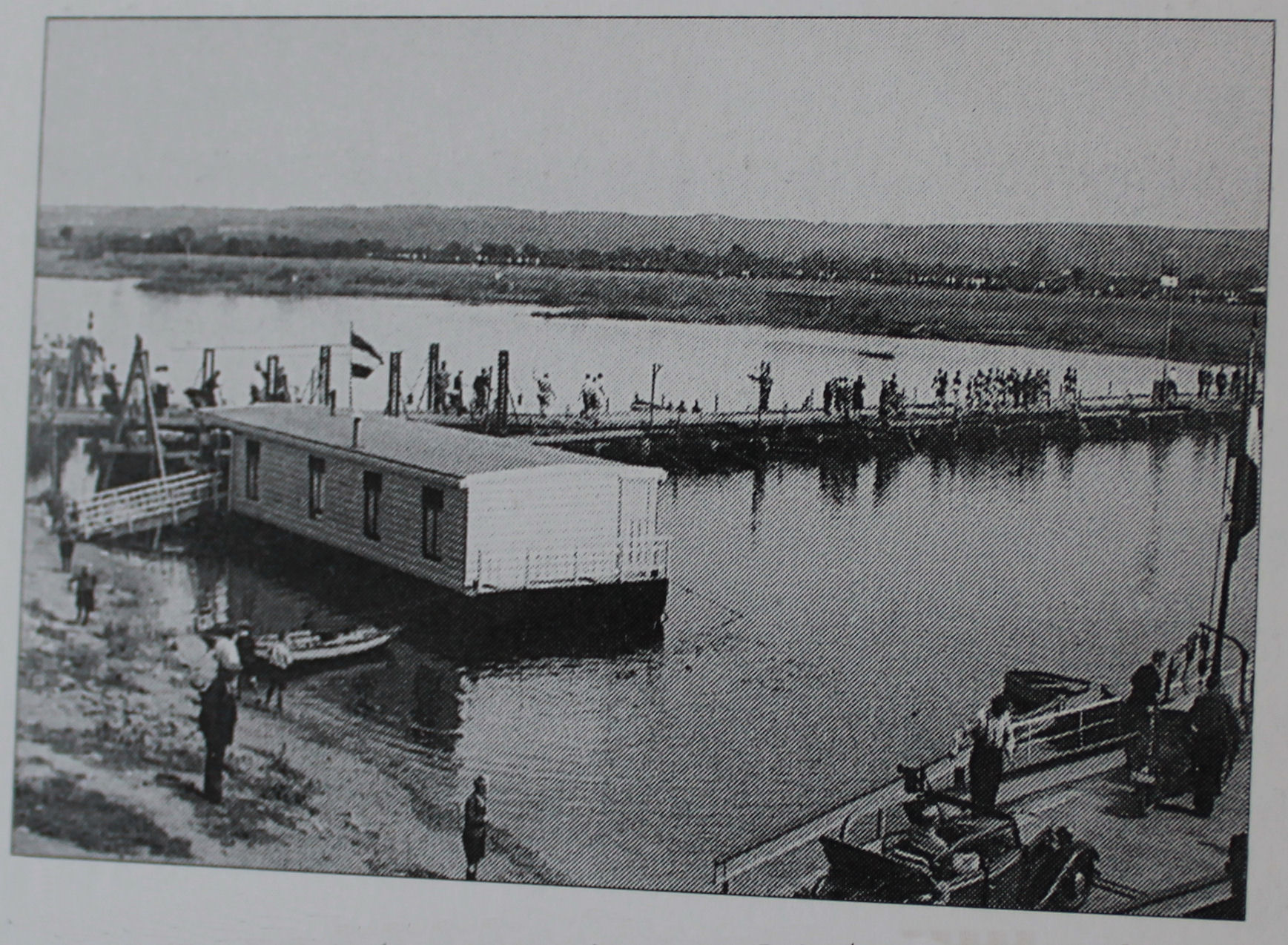 3) 3)
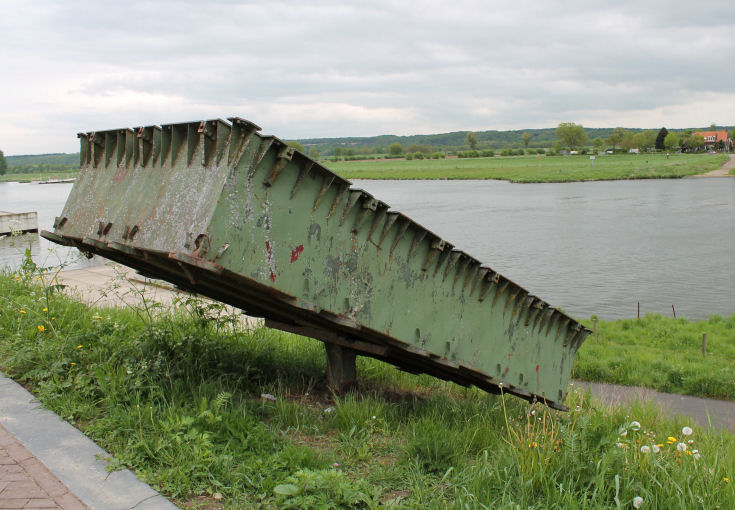
1) Location in
River Meuse on period map where push
dagger and scabbard were recovered
from river bottom
2) On
foreground: the boat used as a house
for the Heere Family who ran the
ferry crossing. Photo from the
1930's.
3) Same location
today. A pontoon bridge is built by
Dutch Army engineers each year for
the Nijmegen March. |
|
EXHIBITIONS:
We visited the location where
this Battle Relic was found in 1992.
Today the Maas Boulevard in Cuijk
features a new river walk and
landing stage. On it, the dimensions
of several Roman structures are
etched in the concrete floor. They
show the sites of a temple and the
bridge in whose remains the push
dagger was discovered. The ferry
boat crossing is now located down
stream but the original landing is
still there. We proved it to be
impossible to throw an object like
this relic, in the middle of the
river where it was found, making it
likely that the knife was lost
midstream. |
|
(click for
enlargements)


_small.jpg)



|
|
Back to Battlerelics
 |
|
|













